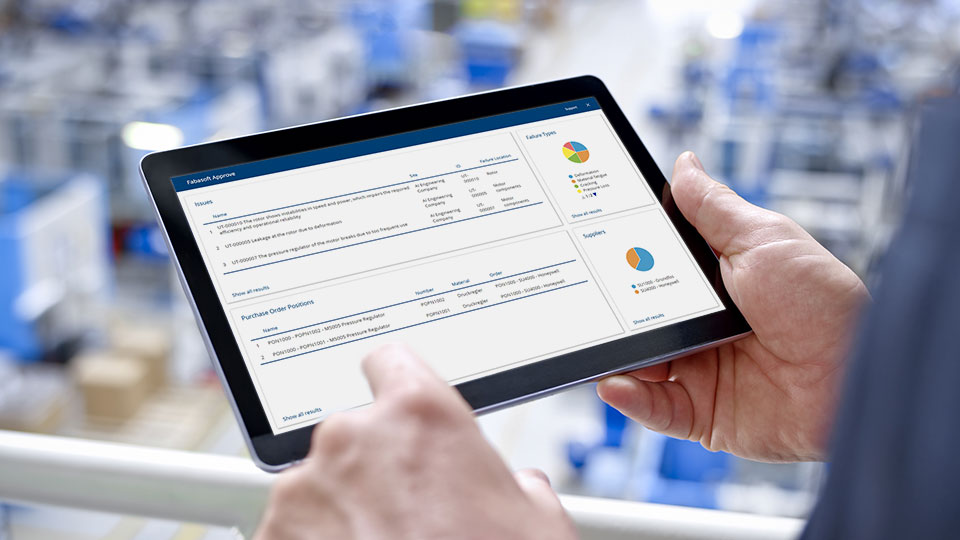In quality management, “Non-Conformance Reports” (NCRs) are valuable as a means of learning from mistakes, proactively preventing them, and bringing the company closer to the goal of “predictive quality”. An AI-supported DMS/QMS¹ supports the processing of deviations and interconnects the learnings along the value chain. The following tips will assist you in efficiently and sustainably processing nonconformities and creating the corresponding reports (NCRs).
Tip 1: Use a cloud-based DMS/QMS for recording and processing non-conformances (NCs)
A non-conformance describes any deviation that can occur at any point in a production process. Depending on the company's level of automation, a machine interface transfers the corresponding data directly to a DMS/QMS, thereby starting an automatic process in which the software also links metadata from other connected systems, such as the ERP. The advantage of this structured data acquisition is significant: Companies pursuing the goal of “predictive quality” or using AI-supported applications require a valid and, above all, structured database for that purpose. The use of cloud technology in certified data centers in the DACH region is precisely what makes cross-company processes along the entire supply chain possible.
Tip 2: Ensure efficient and correctly documented processing of the “non-conformances” (NCs) according to CAPA or 8D
The first step in addressing a defect is a precise identification of the error. This is done by means of Non-Conformance Reports (NCRs), which serve as a tool for systematically documenting questions and problems.
Various methodologies, such as CAPA (Corrective and Preventive Action, e.g. in medical technology) or the 8D process (e.g. in automotive, mechanical and plant engineering), have become established for processing NCRs, depending on the industry. During this process, nonconformities can be freely categorized – depending on the severity of the defect and the customer's prioritization, it is possible to use e.g. only a 2D or a 6D process. An implicit root cause analysis – in other words, a search for the cause of an error – is of crucial importance in order to avoid similar mistakes in the future by taking preventive measures.
Tip 3: Increase the quality of your audits by processing defects in a standard-compliant manner.
Different ISO standards define nonconformities (NCs) in different ways. ISO 9001 describes them as “deviations from the requirements of the quality management system (QMS)”. By contrast, the Food and Drug Administration (FDA) medical device regulations classify “any performance deviation of the device” as a nonconformity. ISO 9101, the standard for aerospace and defense organizations, concretely defines NCRs as a part of the requirements for documenting audit results.
Using AI-supported DMS/QMS, departments can independently manage forms and draw up industry-specific BPMN processes. These serve as documentation for certifications and can also be executed as digital workflows. This system support makes sure that employees automatically comply with the standardized QM processes.
The integrated time travel function makes every processing step traceable and forms a valuable building block in audit management. This way, auditors have an overview of completed process steps at all times.
Tip 4: Achieve continuous improvement through proactive, cross-plant defect management
Associated metadata (such as order information, suppliers, and information about internal supervisors) are automatically integrated into the NC process by smart DMS/QMS via an ERP interface.
The example of supplier audits nicely illustrates this process: The cloud-based software connects customers and suppliers directly in the process. This reduces media disruptions and the potential for errors. A comprehensive NCR for customer complaints is of great relevance for after-sales processes. The collected NCR data can also serve as a basis of information for negotiations in purchasing and contribute to supplier evaluation.
These learnings then automatically flow into the database and the DMS/QMS transfers them back into the ERP and to all connected systems. Thus, “Predictive Quality” comes within reach: The goal is to identify failure patterns and potential patterns, to capture them and then process them for future processes (such as FMEA – Failure Mode and Effects Analysis).
Tip 5: Offset the shortage of skilled workers by using AI functions to process NCRs.
In quality management, extensive data and countless documents have to be taken into account when solving problems. Experienced employees have developed their expertise over many years and know where to find and use information. Due to a shortage of skilled workers, fluctuation and retirements, this implicit knowledge is lost. Efficiently handling quality processes along the supply chain thus turns into a challenge.
The artificial intelligence from Mindbreeze, seamlessly embedded in the Fabasoft Approve DMS/QMS, compensates for this loss of know-how. 360-degree views of defects help in troubleshooting: For instance, a material number noted in a technical drawing can be used to view order information for the component or find similar deviations. In the course of the 8D process, the AI analyzes related defects and provides suggestions for corrective or immediate action at the push of a button.
Employees can use the integrated AI chat to query individual documents or entire technical files. The AI extracts the information and provides a suitable answer in natural language.
¹ Document Management System (DMS) and Quality Management System (QMS)




